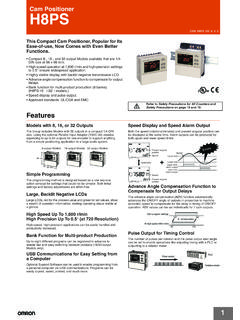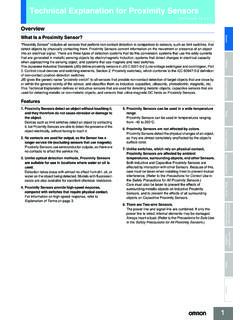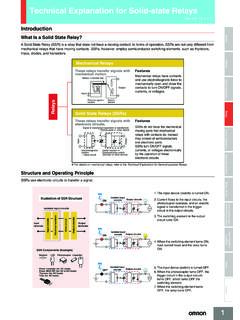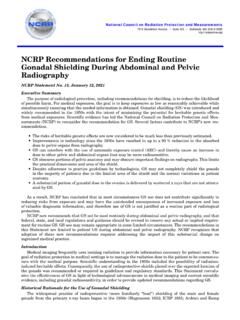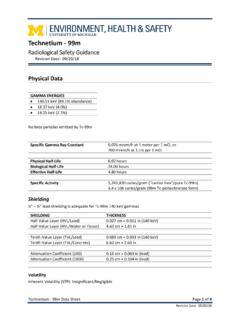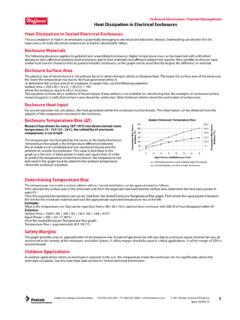Transcription of Technical Explanation for Proximity Sensors - Omron
1 SensorsSwitchesSafety ComponentsRelaysControl ComponentsAutomation SystemsMotion / DrivesEnergy Conservation Support / Environment Measure EquipmentPower Supplies /In AdditionOthersCommon1 CSM_Proximity_TG_E_6_2 Technical Explanation for Proximity SensorsOverviewWhat Is a Proximity Sensor?" Proximity Sensor" includes all Sensors that perform non-contact detection in comparison to Sensors , such as limit switches, that detect objects by physically contacting them. Proximity Sensors convert information on the movement or presence of an object into an electrical signal. There are three types of detection systems that do this conversion: systems that use the eddy currents that are generated in metallic sensing objects by electromagnetic induction, systems that detect changes in electrical capacity when approaching the sensing object, and systems that use magnets and reed Japanese Industrial Standards (JIS) define Proximity Sensors in JIS C 8201-5-2 (Low-voltage switchgear and controlgear, Part 5: Control circuit devices and switching elements, Section 2.)
2 Proximity switches), which conforms to the IEC 60947-5-2 definition of non-contact position detection gives the generic name " Proximity switch" to all Sensors that provide non-contact detection of target objects that are close by or within the general vicinity of the sensor, and classifies them as inductive, capacitive, ultrasonic, photoelectric, magnetic, Technical Explanation defines all inductive Sensors that are used for detecting metallic objects, capacitive Sensors that are used for detecting metallic or non-metallic objects, and Sensors that utilize magnetic DC fields as Proximity Proximity Sensors detect an object without touching it, and they therefore do not cause abrasion or damage to the such as limit switches detect an object by contacting it, but Proximity Sensors are able to detect the presence of the object electrically, without having to touch contacts are used for output, so the Sensor has a longer service life (excluding Sensors that use magnets).
3 Proximity Sensors use semiconductor outputs, so there are no contacts to affect the service Unlike optical detection methods, Proximity Sensors are suitable for use in locations where water or oil is takes place with almost no effect from dirt, oil, or water on the object being detected. Models with fluororesin cases are also available for excellent chemical Sensors provide high-speed response, compared with switches that require physical information on high-speed response, refer to Explanation of Terms on page Proximity Sensors can be used in a wide temperature Sensors can be used in temperatures ranging from 40 to 200 Proximity Sensors are not affected by Sensors detect the physical changes of an object, so they are almost completely unaffected by the object's surface Unlike switches, which rely on physical contact, Proximity Sensors are affected by ambient temperatures, surrounding objects, and other Inductive and Capacitive Proximity Sensors are affected by interaction with other Sensors .
4 Because of this, care must be taken when installing them to prevent mutual interference. (Refer to the Precautions for Correct Use in the Safety Precautions for All Proximity Sensors .)Care must also be taken to prevent the effects of surrounding metallic objects on Inductive Proximity Sensors , and to prevent the effects of all surrounding objects on Capacitive Proximity There are Two-wire power line and signal line are combined. If only the power line is wired, internal elements may be damaged. Always insert a load. (Refer to the Precautions for Safe Use in the Safety Precautions for All Proximity Sensors .) Technical Explanation for Proximity Sensors2 SensorsSwitchesSafety ComponentsRelaysControl ComponentsAutomation SystemsMotion / DrivesEnergy Conservation Support / Environment Measure EquipmentPower Supplies /In AdditionOthersCommonOperating PrinciplesDetection Principle of Inductive Proximity SensorsInductive Proximity Sensors detect magnetic loss due to eddy currents that are generated on a conductive surface by an external magnetic field.
5 An AC magnetic field is generated on the detection coil, and changes in the impedance due to eddy currents generated on a metallic object are methods include Aluminum-detecting Sensors , which detect the phase component of the frequency, and All-metal Sensors , which use a working coil to detect only the changed component of the impedance. There are also Pulse-response Sensors , which generate an eddy current in pulses and detect the time change in the eddy current with the voltage induced in the coil.(Qualitative Explanation )The sensing object and Sensor form what appears to be a transformer-like impedance changes can be viewed as changes in the resistance that is inserted in series with the sensing object. (This does not actually occur, but thinking of it this way makes it easier to understand qualitatively.)
6 Detection Principle of Capacitive Proximity SensorsCapacitive Proximity Sensors detect changes in the capacitance between the sensing object and the Sensor. The amount of capacitance varies depending on the size and distance of the sensing object. An ordinary Capacitive Proximity Sensor is similar to a capacitor with two parallel plates, where the capacity of the two plates is detected. One of the plates is the object being measured (with an imaginary ground), and the other is the Sensor's sensing surface. The changes in the capacity generated between these two poles are objects that can be detected depend on their dielectric constant, but they include resin and water in addition to Principle of Magnetic Proximity SensorsThe reed end of the switch is operated by a magnet.
7 When the reed switch is turned ON, the Sensor is turned by Detection MethodSensing objectSensorThe transformer-like coupling condition is replaced by impedance changes due to eddy-current objectSensorMagnetItems requiringconfirmationInductive Proximity SensorsCapacitive Proximity SensorsMagnetic Proximity SensorsSensing objectMetallic objects (iron, aluminum, brass, copper, etc.)Metallic objects, resins, liquids, powders, noiseAffected by positional relationship of power lines and signal lines, grounding of cabinet, Marking (EC Directive compliance)Sensor covering material (metal, resin).Easily affected by noise when the cable is no supplyDC, AC, AC/DC, DC with no polarity, method, power supply consumptionDepends on the power supply, , DC 2-wire models, DC 3-wire models, AC, 2-wire models are effective for suppressing current distanceThe sensing distance must be selected by considering the effects of factors such as the temperature, the sensing object, surrounding objects, and the mounting distance between Sensors .
8 Refer to the set distance in the catalog specifications to determine the proper distance. When high precision sensing is required, use a Separate Amplifier environmentTemperature or humidity, or existence of water, oils, chemicals that the degree of protection (refer to the Degree of Protection) matches the ambient vibration, shockAn extra margin must be provided in the sensing distance when selecting Sensors for use in environments subject to vibration and prevent Sensors from vibrating loose, refer to the catalog values for tightening torque during of tightening torque, Sensor size, number of wiring steps, cable length, distance between Sensors , surrounding the effects of surrounding metallic and other objects, and the specifications for the mutual interference between Explanation for Proximity Sensors3 SensorsSwitchesSafety ComponentsRelaysControl ComponentsAutomation SystemsMotion / DrivesEnergy Conservation Support / Environment Measure EquipmentPower Supplies /In AdditionOthersCommonExplanation of TermsStandard Sensing ObjectA sensing object that serves as a reference for measuring basic performance, and that is made of specified materials and has a specified shape and DistanceThe distance from the reference position (reference surface) to the measured operation (reset) when the standard sensing object is moved by the specified DistanceThe distance from the reference surface that allows stable use, including the effects of temperature and voltage, to the (standard)
9 Sensing object transit position. This is approximately 70% to 80% of the normal (rated) sensing (Differential Travel)With respect to the distance between the standard sensing object and the Sensor, the difference between the distance at which the Sensor operates and the distance at which the Sensor Time t1: The interval from the point when the standard sensing object moves into the sensing area and the Sensor activates, to the point when the output turns ON. t2: The interval from the point when the standard sensing object moves out of the Sensor sensing area to the point when the Sensor output turns Frequency The number of detection repetitions that can be output per second when the standard sensing object is repeatedly brought into Proximity . See the accompanying diagram for the measuring With a Shielded Sensor, magnetic flux is concentrated in front of the Sensor and the sides of the Sensor coil are covered with metal.
10 The Sensor can be mounted by embedding it into With an Unshielded Sensor, magnetic flux is spread widely in front of the Sensor and the sides of the Sensor coil are not covered with metal. This model is easily affected by surrounding metal objects (magnetic objects), so care must be taken in selecting the mounting sensing objectProximity SensorSpecified sensing object: Material Shape Dimensions Speed, distanceSensingobjectSensingsurfaceProxi mity SensorReferencepositionSet distanceRated sensing distanceOutputSensingsurfaceProximity SensorSensingobjectReset distanceSensing distanceHysteresisOFFONO utputProximity SensorSensingobjectWithin rangeOutside of rangeONt1t2 OFFP roximity SensorSensingobjectSensing areaOutput(Sensing distance)Standard sensing object12f=1 Non-metalMM2Mt1t3t2 Proximity SensorOutputt1 + t2 Sensing objectProximity SensorOutputSensing objectProximity SensorOutputTechnical Explanation for Proximity Sensors4 SensorsSwitchesSafety ComponentsRelaysControl ComponentsAutomation SystemsMotion / DrivesEnergy Conservation Support / Environment Measure EquipmentPower Supplies /In AdditionOthersCommonTake the following points into account when selecting a DC 2-wire model (polarity/no-polarity).
